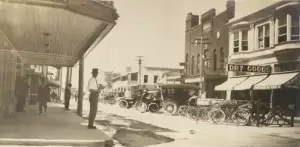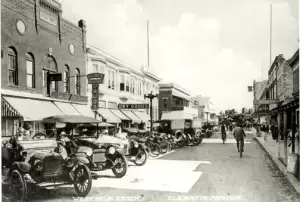Getting Around
Walter Chillingworth III, born in 1893, explained in 1962 that bicycles replaced boats as the main mode of transportation, once the roads had a surface harder than sand.
For bicycle parking, Clematis Avenue … had pipes driven the whole length, from up on top of the hill … down to the City Dock, where Myrtle Avenue [South Clematis] joins it now. Those places were filled with bicycles. I have seen them the entire length, all filled up.
We used to ride sometimes as far as from here to Miami on a Sunday. I never rode the round trip in one day, but Henry Burkhardt [and] Arthur Lyman in Boynton [have]. It wasn’t too bad because there was no traffic.Walter Chillingworth III

By 1904 Clematis was paved “from curb to curb.” As traffic increased, City Engineer Franklin Sheen switched from using oyster shell to coquina rock. Chillingworth recalled: “We were getting rock from down in Naranja from the E.T. Maule Construction Company, located at what was then Ojus.” The town of Ojus would now border Aventura and North Miami Beach. In 1913 Palm Beach County was mining its own limestone to use for road material and other applications.
As more roads were paved, automobiles slowly appeared in Palm Beach and West Palm Beach. Jessie Griffin Sheen recalled the first automobiles in West Palm Beach about 1906 to 1908. G. C. “Curtis” Barco and George R. Lyman, who sold and rented bicycles from about 1900, owned the first two automobiles in Palm Beach, according to Lyman’s wife, neé Daisy Butler: “I don’t know whether one was a Ford or not, but [they were] just little one-seaters.” Barco and Lyman rented the cars to tourists, who had nowhere to ride but up and down County Road.

The first car remembered by Lula Angevine Currie was owned by George Potter: “I suppose it was a Ford, it was just a little buckboard.” Edith Miller lived on Belvedere Road and also remembered Potter’s car: “[He] had a little runabout, some kind of skeleton thing, and he used to drive out—he used to own a grove out there. There [was] a hill there where you come down over the hill, it’s been filled in. And he sometimes couldn’t get back up that hill. And they’d all get out and push back up that hill. It was a noisy thing!”
The Majewski family owned City Bakery on Clematis Street from about 1895 to 1913. Their daughter Mary Louise said in 1962:
The first automobile that I can think of was an electric one, you know, and I can remember we’d hear it, and if we had a customer in the store, we left the customer and went to the front door. Everybody did, to watch that automobile come down the street. It was owned by a German couple that lived on Evernia Street that wintered here, and oh, it was very fancy. They had little flowers on the sides, you know, little artificial flowers.
Mary Louise Majewski

